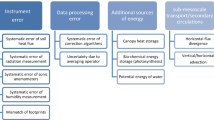Abstract
Possibilities of laboratory simulation of two different atmospheric layers — stratospheric and boundary layer — are considered. The laboratory simulation is performed by fully developed turbulent flows of mercury (Re∼7×104) in strong magnetic fields. The processes of direct and inverse transfer of energy and passive scalar are investigated.
Similar content being viewed by others
References
Branover, H., Sukoriansky, S., 1988.Turbulence Peculiarities Caused by Interference at Magnetic Fields with the Energy Transfer Phenomena. AIAA, Progress in Astronautics and Aeronautics, Vol. 112, pp. 87–99.
Gage, K.S., Nastrom, G.D. 1986.Theoretical Interpretation of Atmospheric Wavenumber Spectra of Wind and Temperature Observed by Commercial Aircraft During GASP. J. Atmosph. Science, Vol. 43, pp. 729–740.
Henoch, C., Hoffert, M., Branover, H., and Sukoriansky, S. 1991.Anisotropic Turbulence: Analogies Between Geophysical and Hydromagnetic Flows. AIAA, Progress in Astronautics and Aeronautics (to be published).
Kraichnan, R.H., Montgomery, D., 1979.Two-dimensional Turbulence Phys. Fluids, Vol. 43, pp. 547–619.
Ozmidov, R.V. et al. 1970.Some Features of the Turbulent Energy Transfer and the Transformation of Turbulent Energy in the Ocean. Atm. Ocean. Phys., Vol. 6.
Platnieks, I., Seluto, S.F. 1989.The Effect of Initial Boundary Conditions Upon the Formation and Development of MHD Turbulence Structure. In Liquid Metal Magnetohydrodynamics, pp. 433–439.
Ruo-Shan, T., Maxworthy, T. 1990.The Dynamics and Geometry of a Two-dimensional turbulent front. Phys. Fluids A (27), pp. 1224–1230.
Sokolov, I.M. 1986.Dimensionalities and other geometric critical exponents in percolation theory. Sov. Phys. Uspekhi, Vol. 150, pp. 924–945.
Sommeria, J., Moreau, R. 1982.Why, How and When MHD Turbulence becomes Two-Dimensional. J. Fluid Mech., Vol. 118, p. 507–518.
Sreenivasan, K.R. 1991.Fractals and Multifractal in Fluid Turbulence Annu. Rev. Fluid Mech., Vol. 23, pp. 539–660.
Starr, V.P. 1968.Physics of Negative Viscosity Phenomena. Mc. Graw Hill, New-York.
Tjernstrom, M. 1990.On the Use of Pressure fluctuation on the random of a subreliner aircraft for boundary layer turbulence measurements. Ninth Symposium on Turbulence and Diffusion, pp. 123–126.
Townsend, A.A. 1966.The mechanisms of entrainment in free turbulent flows. J. Fluid Mech., Vol. 26, pp. 689–715.
Author information
Authors and Affiliations
Rights and permissions
About this article
Cite this article
Branover, H., Bershadskii, A., Eidelman, A. et al. Possibility of simulating geophysical flow phenomena by laboratory experiments. Boundary-Layer Meteorol 62, 117–128 (1993). https://doi.org/10.1007/BF00705549
Received:
Issue Date:
DOI: https://doi.org/10.1007/BF00705549




